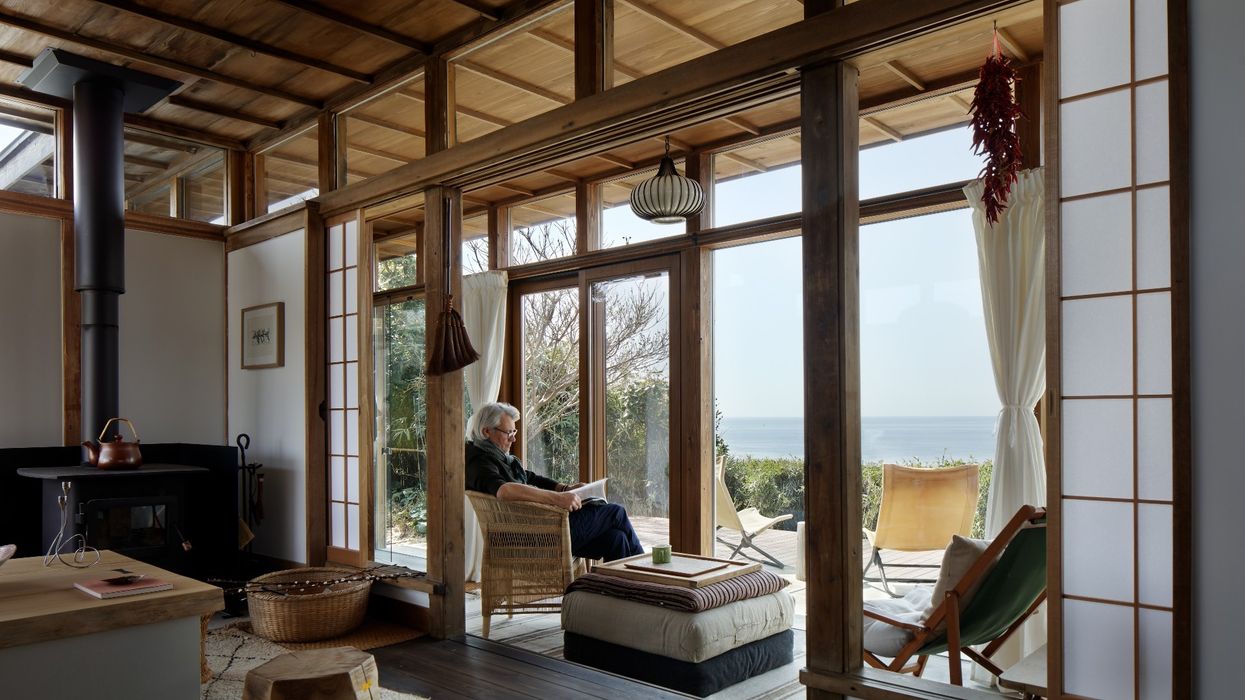These Collectors Filled Their Traditional Japanese Home with Worldly Possessions
But when it came to art, the sweeping views did the trick.

Giselle Go and Philippe Terrien, founders of Japanese clean skincare DamDam, reside in Tokyo during the working week. Exhausted by the exhilaration of the city, the busy couple was looking for a second home to expatriate each weekend. Their plan was the mountains—then they saw a view that changed their minds. A small pied-à-terre in Misaki, a town just outside Tokyo, bewitched them with its sprawling scenery of the Pacific Ocean and Mount Fuji. “When we saw the incredible view we totally forgot that we wanted to be in the mountains,” Go recounts. “We said, ‘Okay, we are actually interested in the property.” But the 75-year-old home was not in great condition.
So began the renovations, with the help of Motosuke Mandai of Mandai Architects. A unique phenomenon of Japanese carpentry (and this home) is the lack of nails. Each wooden beam is crafted to fit perfectly together like a puzzle. Giselle and Phillippe, who possess a reverence for the country’s craftsmanship, wanted to retain as much of the original concept as possible while adding a breath of modernity. The single-bedroom, single-bathroom home was originally partitioned by shoji screens. They removed the paper from the structures, but kept the beams to open the space and maintain the aesthetic feel. They did the same on the exterior walls, but added windows rather than leave gaping holes. “Now, we can enjoy the sea while cooking here in the kitchen,” says Phillippe, the chef in this equation. Lined with Phillippe’s impressively dense spice rack and ceramics collection, the kitchen plays a central role which the renovation underscored.
If the kitchen is for Terrien, the bathroom is for Go. As the newly revamped kitchen took over the original bathroom, the former Editor-in-Chief of Harper’s BAZAAR Singapore added an extension to the house (one that specifically would fit a much larger tub). Though the couples’ priorities may lie on different sides of the house, their aesthetics are surprisingly similar. “Both of us have spent most of our lives outside of our hometown or home country,” explains Go, who grew up in the Philippines and has been in Japan for roughly nine years after working abroad. Terrien came from France as a 17-year-old student and essentially never left. Now, they travel every chance they get.
“I think both of us have a nomadic sensibility,” Go continues. “We are always fascinated by other cultures.” Proof lies in the collections exhibited in their home. One of their beloved pastimes is visiting different prefectures of Japan, collecting pottery from one then washi (Japanese rice paper) from another then displaying their bounty on the house’s many open shelving units. They’ve mixed those things in with Arne Jacobsen chairs from an old apartment in Paris and a refurbished David Chipperfield dining table. Another chair hails from Africa. Textiles journeyed from India and objects from Morocco. And anything original to the house that was in decent enough shape, they kept—think a rattan table in the living room and old fishing baskets left by the stove. A “méli-mélo” mix of things, as Terrien describes it.
In the common area, the soft rounded edges of a barrel chair along with orb-like white lanterns strike a contrast with the straight lines and right angles of the Japanese architecture. “Japanese design is all about the perfection of lines,” says Go. “It's not a lot of curved shapes and silhouettes, but we intentionally brought them in just because we find Japanese design obviously super beautiful, but sometimes it doesn't feel cozy or homey.” And when I ask what it feels like to decamp here on a Thursday night after a long weekend, they can confirm it now feels like home. “There's always so many things happening in Tokyo,” laughs Go. “So this is a place where we can tell friends, ‘Well, we're not in town. We can't see you.’”
Want more stories like this?
Inside A Baltimore Hotel That's *Almost* Too Much
At Home With Footwear Designer Emme Parsons
Inside the Upper East Side Closet of Ashley Stark




